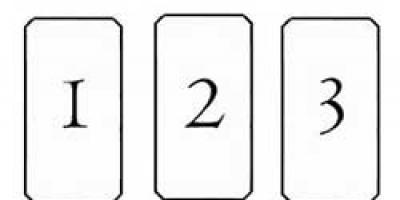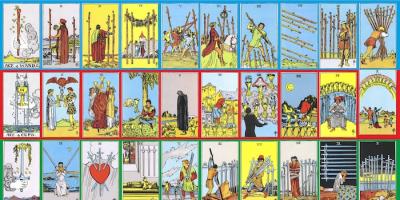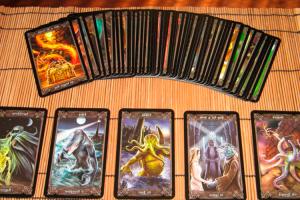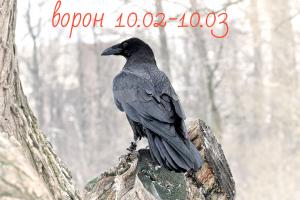The Book of Changes contains two parts. The first part of the book presents the hexagrams themselves, and the second part of the book reveals their meaning and provides interpretation of the hexagrams by various authors. Many great Chinese sages, including Lao Tzu and Confucius, were involved in the interpretation of hexagrams.
In the Book of Changes, certain life situations are revealed in 64 hexagrams. In the commentaries of the Book of Changes, philosophers comprehend this situation. It is necessary for the fortuneteller to pass through the deep meaning of the hexagram, try the situation on himself and draw conclusions. The page talks in detail about the technique of fortune telling, obtaining hexagrams and the principles of their interpretation. And here is a table in which you look at the number of your hexagram, click on the number and get an interpretation of the hexagram.
| Upper trigram | ||||||||
|
Lower |
|
|||||||
|
|
||||||||
For ease of interpretation, you need to divide the hexagram into two trigrams: upper and lower. The top one consists of three lines, and the bottom one consists of three lines. This will make it easier for you to find it in the table. Then, at the intersection of the column and row of the resulting trigram figures, you look at the number of your hexagram in the table. Click on the number received at the intersection and read the interpretation of the hexagram that appears. All that remains is to think about how accurately it describes your life situation. It should be noted that there are very ambiguous revelations, for the interpretation of which you need to turn to the very depths of your soul. If you are able to understand the wisdom of the Book of Changes, then it will always give you the right advice and will forever become an indispensable assistant for you in difficult life situations.
The symbolism of the “Book of Changes” permeates the novel “The Glass Bead Game” by the Swiss writer-philosopher G. Hesse, where an attempt is made to synthetically model the structure of the world with the help of hexagrams.According to legend, trigrams were invented by the semi-mythical emperor of China Fu-Xi, or Bao-Xishi. His name means “He who raided sacrificial animals.” He was born after his mother stepped on the footprint of a giant. Fu-Xi invented nets and immersed himself in contemplation of traces of animals, birds and shadows of trees. One day, a turtle came out of the Lo (Lotui) River, with the letters “lo-shu” inscribed on its back. A dragon horse with the mysterious symbols “he-tu” appeared from the He (Huang He) River. It is possible that the trigrams go back to the cracks on lamb shoulders (bu) and to the fibers of yarrow (shi), by which the ancestors of the Chinese of the Shang-Yin and Zhou eras used to tell fortunes. Geometric signs come from “bu” and numerical symbolism from “shi”.
The Chinese believe that Wen Wang, Zhou Gong and Confucius, by superimposing trigrams on each other, created 64 hexagrams (liushis-gua) and 384 traits-xiao. They allegedly created the “I-Ching” (Book of Changes), or “Zhou-I”. This is one of the oldest monuments of Chinese literature, second only to the Shi Jing (Book of Songs). When books were burned during the Qin era, the I Ching survived because it had practical (fortune-telling) applications.
The I Ching was formed on the basis of agricultural folklore on the territory of the Jin or Qin fiefs in Western China between the 8th and 7th centuries. BC. Over time, a large school of Yijing studies (Yi Xue) developed. Extensive commentaries have been compiled on the Book of Changes.
“Shi-I” (10 wings), of which the most interesting is “Siqi-Zhuan” (Tradition of aphorisms). Here is one of the quotes from there: “Change has the Great Limit of Ty-Di. They give rise to two images, two images - four images, four images - 8 trigrams that determine Fate. The latter forms the Great Cause.”
The Chinese have improved the ancient system of predictions, creating a flexible and at the same time intricate apparatus of 64 characters. They gave the hexagrams dynamics, so that it was possible to trace the transformation of a thing into its opposite and back. Each of the 64 liushis-gua expresses a certain life situation in time from the point of view of its gradual development. According to natural philosophical constructs, predictions can be carried out at several interconnected levels at once - cosmic, social and intrahuman.

****************************************************************************************************
question:
Guess
Tradition says that the legendary Chinese ruler Fu Xi(2852 - 2737 BC) once saw a huge turtle swim out of the Yellow River onto the shore, on the shell of which mysterious signs were inscribed, consisting of solid and broken lines. In their combination, Fu Xi saw a system of symbols of the universe, where everything arose as a result of the interaction of earth and sky. And they, according to the ruler, were symbolically depicted with dashes. Having understood the system of their location, Fu Xi created the “Book of Changes”. She is the most famous work of ancient Chinese philosophy, which has become a kind of oracle that helps answer pressing questions.
After unraveling the genetic code, scientists drew attention to the amazing similarity of the I Ching fortune-telling system with its 64 hexagrams and 64 code “words” in the DNA molecule containing the genetic information of any living organism. What if the twists of DNA are nothing more than the words of a “life diary” kept since ancient times, and is the I Ching intended to make this “diary” speak? After all, 64 hexagrams are not just “code” words, but a description of the state of a person’s personality, moreover, 64 keys to these states, containing six stages of their development.
What to do
The book consists of graphic figures - the so-called hexagrams, or gua. There are 64 of them. According to the number of ways in which two lines - dashed and solid - can be arranged in a group of six, one above the other. The lines symbolize two main cosmic energies - yin (broken) and yang (solid). Their combination forms hexagrams, each of which gives an answer to a question.
How should one guess?
1. Mentally formulate a question. And it’s better not trivial, but very important for you.
2. Click on the "Throw coins" button
Let “heads” be “yang” and “tails” be “yin”. Look what happened in the end. If the majority of coins (two or three) lay heads up, then yang prevails. If "tails" - yin. Since there are six lines in the hexagram, the coins must be thrown in six steps.
3. After the hexagram is compiled, read the explanation. Fortune telling will be effective if you are fixated on your question. Try to guess no more than once a month.
Comments (1)
19.10.2014 13:32
Loved this fortune telling! If the situation is good, I receive and feel support, and if the interpretation is not very good, then I talk philosophically. After all, everything will be fine anyway!
The Book of Changes still influences many areas of Chinese life: politics, art, mathematics, philosophy, etc. Its significance in the development of the spiritual and cultural life of the country is very great. Why is it so significant?
Coins are tossed
Fortune telling Book of Changes
1. Relax and let go of negative thoughts
2. Focus on what excites you
3. Formulate the question as precisely as possible
4. Toss the coins 6 times
All that remains is to throw:
What is the Book of Changes?
The Book of Changes, or as it is also called - I Ching, is a real treasury of wisdom that has come to us since the times of Ancient China. This is one of the oldest monuments of world literature, which has been known for more than three thousand years. The Book of Changes is one of the oldest divination systems, and consists of 64 hexograms, each of which, in turn, consists of an upper and lower trigram. When considering all hexograms together, we can see the complete picture of the situation we are interested in with all stages of its development. At the same time, the situation is inextricably linked with the past and the future, and it can only be determined by the method of the balance of forces that governs change. At the moment of circulation, the I Ching shows exactly the hexogram that most accurately reflects the situation at the moment.
Why the Book of Changes works
The thing is that this method of fortune telling provides access to our subconscious, because the answers to any question that we are able to ask can be found within ourselves. The subconscious is directly connected to the universal information field, and based on intuition, we recognize the answers, drawing them from the unconscious depths. The Book of Changes can become the best advisor, can accompany us in the process of development and better than any, even an experienced fortune teller, will help us hear our inner voice, abstracting from our illusions and prejudices.
Fortune telling technique using the Book of Changes
Classic fortune telling is a very long ritual, but in Europe they use a simplified version. For fortune telling you will need:
- three coins;
- 64 decoding of hexogram meanings.
In the Chinese tradition, special coins of happiness were used, one side meant Yin energy with two hieroglyphs depicted, the other side meant Yang energy with four hieroglyphs.
Now let's get down to the process itself.
- It is important to sit in a room isolated from extraneous noise and relax in a quiet, peaceful environment.
- Focus on the situation for which you want to find out the interpretation.
- Make up a specific question to which you are looking for an answer. The interpretation of the answer directly depends on this.
- Then start throwing coins. The free online version of the Chinese book will give you the answers itself.
- This is followed by an interpretation of the response received. The answer to the question will be the text of the “Main Hexogram”, the essence of which you will need to grasp. Key words that attract attention and will convey a warning or recommendation.
- At the end of the fortune-telling, express gratitude to the Book of Changes, show a careful and respectful attitude towards it.

How to formulate a question correctly
You can turn to the Book every day with a question. Just don’t ask the same thing several times in a row, because in this case the I Ching may stop answering. If you are not satisfied with the answer, it is better to just wait until the next morning and ask about the situation again. When formulating a question, it is very important to avoid words like “What will happen..?” It’s better to start formulating your questions like this:
- What will happen if I do...;
- What should I do in the situation...;
- Does it make sense for me to do...;
- How should I react to such and such a situation?..;
- What kind of relationship do I have with...;
- What is the meaning of my dream today?..
- How should I behave with...?
As you can see, the main thing in questions is maximum specificity.
The Book of Changes differs from other fortune-telling systems in its focus on events. It is impossible to predict thoughts, feelings, relationships according to the Canon, but to the question: “What will happen?” Canon will give a very good and accurate answer. In addition, online fortune telling using the Book of Changes (I Ching) provides several answer options depending on the actions of the questioner.
The answers from the Book of Changes, when doing online fortune telling, are not always optimistic; the vast majority of them say that only with hard work will you be able to achieve your goal. This is in accordance with Chinese philosophy, which believed in the obligatory expenditure of labor and obligatory reward for this invested labor.
In addition, it should be taken into account that the I Ching was written by people with a completely different way of life, and the difference from Russian or, especially, European approaches is quite large.
So what is fortune telling using the Book of Changes (I Ching)?
Time in the view of modern science is not a segment connecting the past and the future, or even a clock, but rather a multi-layered sandwich, part of which is located outside our three-dimensional world. In other words, each living being is simultaneously in the past, in the present, and in the future. The future cannot be predicted only by studying the past. There, ahead, beyond the present, a whole fan of events can await us with just one word spoken today. Mantic, tantric, shamanic and other fortune-telling practices were created due to the non-linearity of time and were called upon by man for self-knowledge and harmonious existence on Earth. There have always been and are very few people endowed with the innate ability to predict the future. Therefore, in ancient times, the very wise created several tools to facilitate penetration into the secrets of time. One of them is in front of you.
Like any multidimensional system, the Book of Changes (I Ching) can be applied in various areas of human life. Using some of the laws of the Book of Changes, you can, for example, achieve a state close to Buddhist enlightenment, hone logic and abstract thinking, and much more. The transcendental roots of the Book of Changes (I Ching) are confirmed by its use in fortune telling or resolving intractable questions.
First they told fortunes with bamboo sticks. Then we switched to dried yarrow stems. We stopped at them too. To be fair, we note that the author uses here an image of a relative of yarrow - hemlock. The fortune-telling technique itself is described in some detail in sinological literature. There is no point in bringing it here. We have reduced it to an understandable minimum.
The person took a bunch of 49 stems in both hands, concentrated on the question, and at the moment of achieving the greatest insight into the essence of the object, divided the bunch approximately in half.
Next, he sorted through the stems in a known manner until the final number was obtained. This number determined the line. To get 6 lines, i.e. hexagrams, he repeated this operation 18 times or three per line. The process of fortune telling using the Book of Changes (I Ching) has not changed at all since then and comes down to two things:
- competently drive away extraneous thoughts from the object of the question and
- Divide the bundle approximately in half in time.
Everything else is a mechanical repetition of hand passes and easy-to-memorize combinations of numbers. Which, by the way, we saved you from. Our fortune telling emulator is practically no different from the traditional method of obtaining hexagrams using yarrow stems. In other words, you can actually divide your virtual bundle roughly in half. This is our find. Well, success in the fight against extraneous thoughts has always and everywhere been a purely personal matter. Here, as you understand, after centuries, nothing has changed either.
As a result, you have the opportunity to plunge into the hoary past and find out the answers to almost any questions.
Why can't we know our entire future? Because there is much more of the future, simply tens or even hundreds of times more than the present, and the book of changes (I Ching) can give 64 x 6 = 384 consistent answers to one question. Contradictions live in us, not in the future...
The Book of Changes was invented by the ancient ruler Fu Xi in the 3rd millennium BC. They say that the book contained all the secrets of the universe, which to this day remain a mystery. The Book of Changes is certainly considered the most mystical fortune telling, which incredibly accurately determines the situation and gives advice.The book consists of 64 symbols - hexagrams. Each hexogram represents 6 lines, which can be whole or interrupted. The interpretation of each hexagram describes the current state of affairs, then the probable future and gives advice on the most optimal behavior to achieve the goal.
Don't ask the same question twice. The first prediction of the Book will be correct. You can get the greatest benefit if you limit yourself to just one fortune-telling and carefully analyze the advice given by the Book. And remember, the Book does not give advice if your intentions are impure and you want to harm another person.
Let us recall that previously coins were used for fortune telling using the Book of Changes. 3 lucky coins were tossed at the same time. If 2-3 coins fell out with the Yang (masculine) side up, then a solid line was drawn. If 2-3 coins lay with the Yin side up (feminine), then a broken line was drawn. Thus, coins were tossed 6 times and 6 lines were obtained - a hexagram. Virtual fortune telling on our website is not inferior to the original fortune telling. You can also toss coins on the table and indicate in the program what came up. As a result, you will receive a hexagram and its interpretation. If you think it's enough for you to relax and concentrate, you can choose to automatically generate lines.









